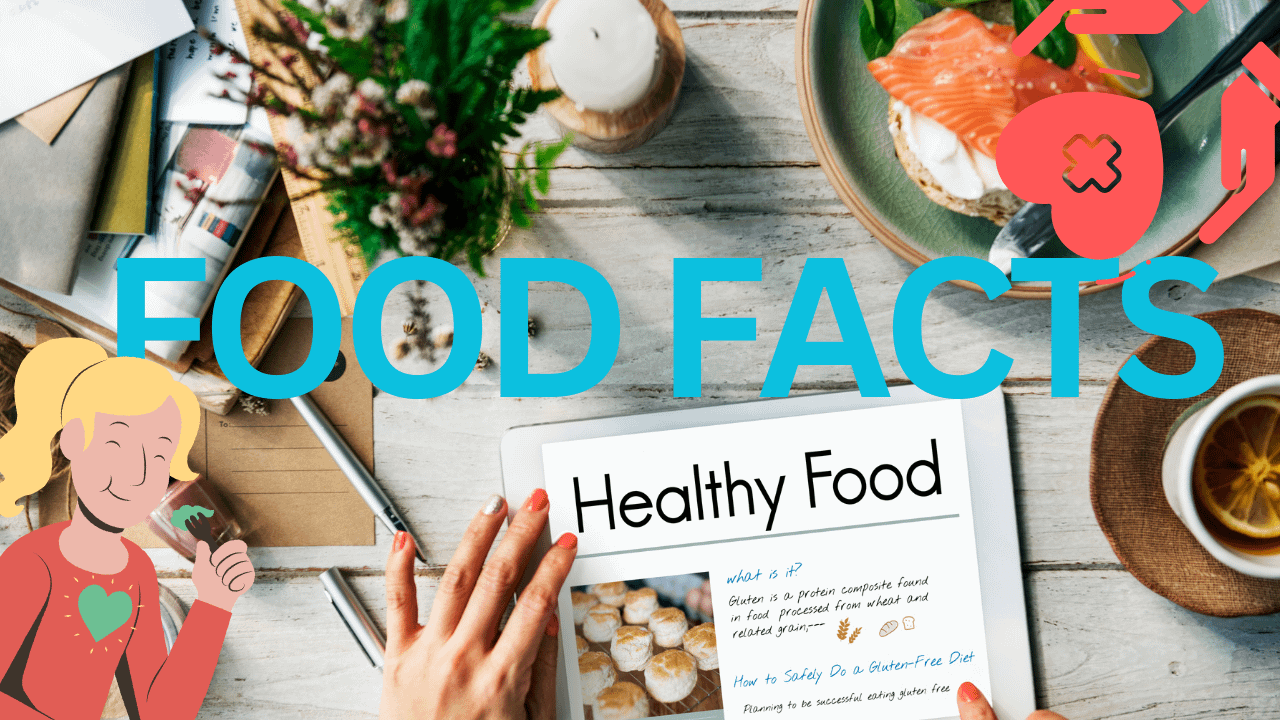
Eating Smart: Essential Food Facts for a Healthier Life
Introduction
When it comes to health, what we eat plays a crucial role in determining our overall well-being. From energizing our bodies to influencing our mood, food is much more than just a source of sustenance. It’s our fuel, our comfort, and sometimes even our medicine. However, with so much conflicting information out there, it’s easy to get lost in the noise of food myths and misconceptions. For instance, do you really need to avoid all carbs to maintain a healthy diet? Spoiler alert: not all carbohydrates are created equal!
In this blog, we’ll clarify some essential food facts, eliminate common misunderstandings, and guide you toward making better nutritional choices. So grab a snack (preferably healthy!), and let’s dive into the wonderful world of food and health.
I. Nutrients That Matter
A. Macronutrients
Carbohydrates: Types and Their Role
Carbohydrates often get a bad rap, but they are essential for energy. Not all carbs are the same; they can be classified into simple and complex carbohydrates. Simple carbs, found in sugary snacks, provide quick energy but can lead to spikes and crashes in blood sugar. Complex carbs, on the other hand, are packed with fiber and nutrients and help keep you full longer.
Proteins: Importance in Bodily Functions
Proteins are crucial for building and repairing tissues, making enzymes and hormones, and supporting immune function. They are made up of amino acids, some of which our bodies can’t produce and must be acquired through food. Including good sources of protein like lean meats, beans, nuts, and dairy in your diet can help you feel satisfied and maintain muscle mass.
Fats: Differentiating Between Healthy and Unhealthy Fats
Fats have also been misunderstood. While saturated and trans fats (found in processed foods) can negatively impact heart health, healthy fats such as monounsaturated and polyunsaturated fats (found in avocados, olive oil, and fish) can actually support heart health and lower bad cholesterol levels.
B. Micronutrients
Vitamins: Key Vitamins and Their Health Benefits
Vitamins, which our bodies need in smaller amounts, play vital roles in processes like energy production and immune function. For instance, Vitamin C helps your body heal, while Vitamin D contributes to bone health.
Minerals: Essential Minerals and Their Functions
Minerals like calcium, potassium, and iron are crucial for various bodily functions. Calcium keeps bones strong, potassium helps balance fluids, and iron plays a role in transporting oxygen through the blood.
Water: Importance of Hydration for Health
Don’t overlook the value of hydration! Water is essential for digestion, temperature regulation, and nutrient transport. Aim to drink enough water throughout the day—it’s simple yet incredibly effective for maintaining health.
C. Phytochemicals
Definition and Examples
Phytochemicals are naturally occurring compounds in plants, responsible for their color, flavor, and disease resistance. They include antioxidants like flavonoids and carotenoids, found in fruits and vegetables.
Health Benefits Associated with Phytochemicals
Many phytochemicals have been linked to reduced risk of chronic diseases, thanks to their anti-inflammatory and antioxidant properties. Incorporating a variety of colorful fruits and vegetables into your diet can help you reap these benefits.
How to Incorporate More Phytochemical-Rich Foods in Your Diet
Snacking on berries, adding leafy greens to your meals, and experimenting with spices like turmeric are great ways to up your phytochemical intake.
II. The Role of Food in Disease Prevention
A. Heart Health
Foods That Promote Cardiovascular Health
Foods like fatty fish, nuts, whole grains, and fruits are known to promote heart health. These foods contain beneficial nutrients, such as omega-3 fatty acids and fiber, which can help maintain a healthy heart.
Understanding Cholesterol and Its Dietary Links
While cholesterol is often seen as the enemy, it’s important to know there’s a distinction between good (HDL) and bad (LDL) cholesterol. Foods that are high in fiber can help lower bad cholesterol levels and support heart health.
The Impact of Sodium on Blood Pressure
Excessive sodium intake can lead to high blood pressure. Reducing your consumption of processed foods and seasoning meals with herbs and spices can help keep your sodium levels in check.
B. Diabetes Management
Low-Glycemic Foods and Their Influence on Blood Sugar
Choosing low-glycemic index foods, such as sweet potatoes and whole grains, can help maintain stable blood sugar levels. These foods digest more slowly and minimally impact blood sugar.
The Role of Fiber in Diabetes Control
Fiber not only keeps digestion stable but also helps regulate blood sugar by slowing down sugar absorption. Including a variety of fruits, vegetables, and whole grains can enhance your fiber intake.
Foods to Avoid for Better Blood Sugar Levels
Processed foods high in sugar and refined carbohydrates can lead to spikes in blood sugar and should be minimized for better health.
C. Cancer Prevention
Antioxidant-Rich Foods and Cancer Risk Reduction
Foods rich in antioxidants, like berries, nuts, and dark chocolate, may lower cancer risk by neutralizing harmful free radicals in the body.
The Role of Red and Processed Meats in Cancer
Studies suggest a link between high consumption of red and processed meats and certain cancer types. Opting for lean protein from sources like fish or beans can be a better choice.
Benefits of a Plant-Based Diet in Lowering Cancer Risks
A plant-based diet focusing on whole foods may not only help in cancer prevention but also deliver plenty of vitamins, minerals, and fiber, all essential for a healthy body.
III. Impact of Food Choices on Mental Health
A. Nutritional Psychiatry
Overview of the Emerging Field of Nutritional Psychiatry
Nutritional psychiatry delves into how our diet affects mental health. Increasing evidence suggests that certain foods can influence mood, anxiety, and cognitive function.
Foods Associated with Improved Mood and Cognitive Function
Include more fruits, vegetables, whole grains, and fish in your meals, as they are linked to better mental health outcomes. Foods rich in B vitamins and omega-3s are especially supportive.
The Gut-Brain Connection: How Food Affects Mental Health
Did you know your gut health is linked to your mental well-being? A healthy gut may lead to improved mood and cognitive function, highlighting the importance of probiotics found in yogurt and fermented foods.
B. Omega-3 Fatty Acids
Sources of Omega-3s and Their Health Effects
Fish like salmon and walnuts are good sources of omega-3 fatty acids, which are vital for brain health. Regular intake can help reduce symptoms of depression and anxiety.
The Relationship Between Omega-3s and Mental Disorders
Research indicates that omega-3s may play a role in managing mood disorders, potentially offering an additional therapeutic approach alongside traditional treatments.
Recommendations for Omega-3 Intake
Aim for at least two servings of fatty fish per week or consider plant-based sources like flaxseeds and chia seeds for their omega-3 benefits.
C. Sugar and Mental Health
The Effects of Sugar Consumption on Mood
While sugar can provide a short-term boost, its overconsumption is linked to increased feelings of anxiety and depression.
Understanding Sugar Addiction and Its Health Implications
The brain can develop a dependence on sugar similarly to addictive substances, leading to cravings and mood swings.
Tips for Reducing Sugar in Your Diet
Start by reading labels and opting for unsweetened alternatives. Gradually reduce sugar in your meals and look for natural sweeteners like honey or fruit.
IV. The Science of Food Pairing
A. Flavor and Nutrition
How Flavor Combinations Can Enhance Nutrient Absorption
Pairing certain foods can enhance nutrient absorption. For example, vitamin C-rich foods can help absorb iron from plant sources.
Pairing Proteins and Carbohydrates for Optimal Health
Combining protein with complex carbohydrates can provide sustained energy and keep you feeling fuller longer. Think of pairing chicken with quinoa or lentils.
The Role of Spices in Nutrient Density
Don’t forget about spices! Not only do they add flavor, but many spices like turmeric have anti-inflammatory properties that promote health.
B. Timing of Meals
Importance of Meal Timing for Metabolic Health
How and when you eat can impact your metabolic health. Regular meal patterns support sustained energy and regulate blood sugar levels.
The Concept of Intermittent Fasting
Intermittent fasting involves alternating eating periods and fasting periods, and some studies suggest it can help with weight control and metabolic health, but it’s essential to find a schedule that suits you.
Best Practices for Meal Frequency
Listen to your body! Eating smaller, frequent meals can help maintain energy levels without overindulging.
C. The Influence of Cooking Methods
Healthier Cooking Techniques and Their Benefits
Opt for healthier cooking methods like steaming, baking, or grilling instead of frying. These techniques can help retain nutrient content while reducing unhealthy fats.
Effects of Cooking on Nutrient Content
Some nutrients are better absorbed when foods are cooked, while others may degrade. For instance, cooking tomatoes increases their lycopene content, offering more benefits than raw.
Foods Best Consumed Raw vs. Cooked
Leafy greens and bell peppers often retain more nutrients when consumed raw, while others like carrots provide more antioxidants when cooked.

V. Understanding Food Labels
A. Decoding Nutrition Facts
How to Read and Interpret Nutrition Labels
Nutrition labels can seem overwhelming, but focusing on serving size and calories can help you grasp what you’re eating. Look for foods that are low in added sugars and high in fiber.
Common Misunderstandings About Serving Sizes
Serving sizes can be misleading; they don’t always reflect what people consume. Compare your portion size to the label to better gauge your intake.
The Significance of Ingredient Lists
Ingredients are listed in order of quantity. Aim for products with whole food ingredients at the top of the list, which indicates a healthier choice.
B. Health Claims and Regulations
Understanding Different Health Claims on Packaging
Terms like “low-fat” or “sugar-free” can be enticing, but they don’t always mean healthy. Always check the ingredients and nutrition facts.
Misleading Terms and Marketing Tactics
Packaging marketing can sometimes be misleading. Look beyond the front label to understand what’s really inside.
The Role of Food Certification Labels
Labels such as organic, non-GMO, and gluten-free can provide valuable information about food quality, allowing you to make informed choices.
C. Choosing Quality Foods
Organic vs. Conventional: What You Need to Know
While buying organic can be more expensive, it may reduce exposure to pesticides and chemicals. Weigh the pros and cons based on your priorities.
The Benefits of Local and Seasonal Foods
Local, seasonal foods are fresher, often tastier, and reduce your carbon footprint. Plus, supporting local farmers can positively impact the community.
Tips for Making Informed Grocery Choices
Create a shopping list, avoid shopping while hungry, and choose whole foods over processed ones to make healthier decisions in the grocery store.
Conclusion
In summary, understanding essential food facts and how they relate to health can empower you to make wiser choices in your daily life. It’s about building a balanced relationship with food, recognizing its impact on both physical and mental well-being. When you arm yourself with knowledge, you’re much better equipped to design a healthier lifestyle.
FAQs
What are the key nutrients I should focus on for overall health?
Aim to include a balance of macronutrients—proteins, carbs, and fats—along with vitamins and minerals.
How can I make better food choices when shopping?
Read labels, prioritize whole foods, and consider seasonal and local produce to make informed choices.
Is it true that some foods can help improve my mental health?
Yes, foods rich in omega-3 fatty acids, probiotics, and vitamins can positively impact your mood and cognitive health.
How do I interpret food labels correctly?
Start by looking at the serving sizes and sugar content, then review the ingredient list for whole food items.
What dietary changes are most effective for disease prevention?
Focus on a diet high in fruits, vegetables, whole grains, and lean proteins, while reducing processed foods and sugars for better health outcomes.
